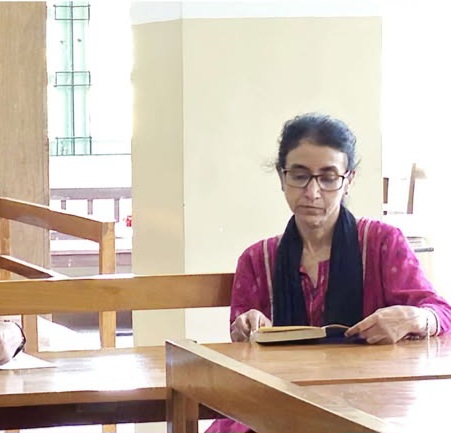Girija Sridhar, a master trainer in communications, explains how self-esteem is an important factor in a child’s growth and personality. It develops through experiences and interactions with parents, teachers, and peers. As adults, we can support children in building confidence and recognising their abilities. With the right guidance, every child can thrive and realise their full potential.

The ingredient that can change the personality of the child, which is very critical, is self-esteem. It means what we think about ourselves. It comes through our childhood. All these things, such as interpersonal relationships with parents or teachers, matter a lot, and in such situations, the child becomes what he is now. The question arises, what can we as parents or teachers do, since we have the power to do it? There are many methods to cater to different types of children, such as slow ones or quick ones. But God has given us all a gift, and when opened, there are good things for the children that will help them.
So, self-esteem refers to the individual’s overall sense of self-worth, a personal value. When we constantly tell a child that he is not capable of doing things, this has an impact on the child’s mind, and he starts thinking that he is not good at things. Personal success is very important for a child, and when he is constantly told that he cannot do it, he starts thinking strongly that he cannot do it. We have to change the world from “I can’t” to “I can.” We are the instruments and well-wishers connected with the child. The relationship comes in various ways, such as how we interact with people, how we take things, etc. If his self-esteem is low, he will not understand anything properly and will negatively interpret everything.
Tom’s story
To cite an example, the story of Mrs. Anderson and her student Tom, who was not doing his homework, did not have any friends, and did not dress properly. His notebooks were filled with red marks. When the principal, a sensible lady, got to see his notebook, she asked Mrs. Anderson about it, and she narrated all the negative points about Tom. The principal asked Mrs. Anderson if she had ever tried to find out the cause of it. Mrs. Anderson said she did not. So, the principal advised her to go to the lower classes and find out about him. In the previous two lower classes, the teacher said that he became dull after his mother passed away due to illness. The Grade 1 teacher said that the child was one of the best students in the class, and she missed Tom. These details made Mrs. Anderson feel very bad about what she had done to the child till then. From the next class onwards, she started talking to him more, and it had a good impact on him. He even presented her with a gift on Teachers’ Day. Mrs. Anderson appreciated the gifts and started to use them immediately. The boy was in full smiles. After he left the school, he became a well-known doctor in New York, and Mrs. Anderson was also invited to his wedding. During the function, he explained how Mrs. Anderson changed his life and was almost his mother. She said his association was an eye-opener for her and taught her what she should have done as a teacher. The story goes to show what we can do to make the children feel self-esteem.
Power of positive talk
Factors like genetics, brain, and chemistry play a role as children grow. So, the brain, which was empty when the children were born, gets filled with positive thoughts and appreciation. Often, the way we talk can be terrible, and when it goes on for a long time, the children cannot be happy, as they are constantly being told they are not good enough. Due to family dynamics and peer influence, when they reach college or school, they get bullied. We have seen in parents that when a child does not perform well like another child, they start telling him that they are not good enough. Jaggi Vasudev says that the child gets hurt by such words. We need to find out the reason behind it. Ultimately, he will refuse to do anything that will impact his career and affect his accomplishments. Children need such encouragement daily to improve their self-esteem.
Noticing silent struggles
The symptoms of low self-esteem are – people have anxiety, feelings of worthlessness, are stuck in their minds, and tend to avoid challenges in life. It is because they feel that they are not going to succeed. The children or elders should not face criticism, comparison, or complaining. Self-criticism that they are not good enough, not able to make friends, and not looking good enough makes them feel worthless. The children need a lot of validation. They also develop physical symptoms such as lack of sleep, low intake of food, and low energy levels. We have to keep asking “why” at all times. Then, we can find ways and means to change their belief in themselves and their worthiness. We should always make it a practice to find out why a child is dull and make a difference to their feelings. In one of the teachers’ training programs, I asked them to pick up colored blocks, while one was a different color. The one who picked it up was not feeling happy and was feeling lonely. This is what happens to a child who is alone. We have to notice the changes in the children and make the change with our kind words. When the children are pointed out for their weaknesses all the time, it affects them a lot. When they go for jobs, they may not achieve their career goals as they do not think highly of themselves.
So, children and adults should stop thinking negatively, get validation, and throw out the 3 C’s from their lives. People hesitate to say no because they want to please others. They cannot take on challenges. There is a difference between confidence and self-esteem. We feel confident that we can easily do this, but self-esteem stops us from doing it, as we do not want to take risks. Improving a child’s mental strength is not easy; we have to keep motivating them. We should learn to treat them with kindness. We should learn to celebrate our achievements and remove negative thoughts. They should never shy away from asking for help from others.
Praise, don’t compare
It is during the initial stages of a child that parents can build him up, lay foundations for what he will be when he grows, which should be strong and full of love. We can give examples from our personal lives when we commit mistakes and explain how we could recover from them. We need to appreciate even his smallest efforts. Self-esteem, confidence, communication skills, and laughter are the ones we want. There is a way of disciplining the child without being harsh. We should keep observing him, his behaviour, and help him to discuss even small things that happened on that day. It is only the parents who can help the children when they are helpless. It may not be easy for teachers with a class of about 40 students, but they can at least make an effort. We can identify the child who needs such attention, and for them, we can do it slowly. Therefore, as parents and teachers, we can make a significant difference in a child’s way of thinking, one that is essential for their mental health, relationships, and overall success. There are three things: mental health, relationships, and achievements. Achievements infuse motivation in the child who has been getting low marks. Now, the teachers and parents should give validation to prevent him from suffering. If a child is anxious, sad, and even crying, we are supposed to make him feel proud of himself, and every little thing has to be appreciated. We need to push them, which is very important. Setting goals is for older children, and asking them to do exercises daily, the parents and teachers can keep telling them that they are the best and use adjectives like amazing, wonderful, and all positive words in a poster, and ask them to stick it in their room. They may feel odd in the first few days, but then they will start feeling self-worth. Saying “I am great” repeatedly in the classes every morning can prove to be an affirmation to bring a healthy smile to the faces of children. The word can’t” will be removed from the dictionary. We must bring out the confidence in them and motivate them for whatever they are doing. Comparison comes in because everybody is doing work except them, and this will not help children grow. We have to make them believe that they are good at things, and not everybody can be good at everything. Parents and teachers can motivate the children by saying that they know so much.
Love, listen, and guide
Abundant love has to be given to the child. We have to observe his reaction when we say something. We may feel we said it nicely, but it might not be so for him. We have to go to their level, talk softly. We should give importance to being with him, listening to him, and helping him. We have to change our methods slowly and be ready to accept the change. Our communication with the child should be a happy one. The practice of speaking at home and in schools should be inculcated to help them in the future, and their effort should be appreciated. The pleasure we get when we change the children is the best reward we can get. Eleanor Brucewell says that no one can make us feel inferior without our consent.
To conclude, I have seen children suffer from low self-esteem. We need to follow the AAA formula, which is Acceptance as they are, Approval of what they are doing, and Appreciation for whatever they do. These will help in improving the self-esteem of all kids in the world.
This is a summary of the talk given by the author on schoolreformer.com
Contact details
Girija Sridhar
Certified Master Trainer in Communication Skills and Logistics
Mobile: 9899122270
Email: girija96@gmail.com






